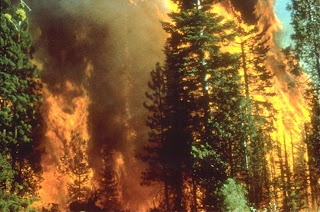Visual rhetoric is one more way of communicating the audience with complex messages in deeper sense. Visual rhetoric communicates in multiple ways at a time and leaves long lasting impression in our minds.
Main purpose of following visual rhetoric in my blog is to show audience one of the effects of deforestation.
Wildlife pleading to stop deforestation on the urban street. Adapted from www.woso.org.ru/tag/environment-ads/
Pathos is quality of literature or speech arousing a feeling of pity, sorrow or compassion. This visual rhetoric reveals one of the major points of my researched essay on deforestation. This image calls on our sense of humanity to stand up for speechless creatures that have been deprived of right to live in their natural homes. Most of us know that it is pretty hard to neglect a pleading being, to pass him/her by, unless we sometimes think that by paying attention, we might encourage laziness and dependence. However, when it comes to true homelessness, to those whose homes have been taken away by illegal methods, we feel so compassionate. Similarly, we feel compassion when we see thousands of wild life species die with starvation and hunger due to lack of dwelling place. What greed and selfishness! What a terrible thing is happening to wildlife due to deforestation!
Logos is a written text that appeals to our intellect or reasoning. The handwritten words on the piece of hard paper with marker --might be charcoal or chalk-- tells us that one of the illiterate wildlife is trying to tell us what human beings are doing every month. The written words like thousand animals are being made homeless poses questions in our mind about how long to it take to wipe them all or to alter the course. The word “Born free” appeals to the concept of biodiversity, which is to be born free and to live free in their territories.
Ethos is the quality that appeals to sense of moral competence or ethics. We know that deforestation or distraction of forestry is not morally right. The chimpanzee looking down in thoughtful manner seems hurt badly, which makes us question our sense of morality. When somebody is extremely hurt and unable to explain the feeling, it is common to be speechless and look down so that the others may think what they did wrong with the situation. This image speaks more powerfully than words for our deeper sense of morality or ethics.
Mythos is the quality that appeals to our common and shared values, beliefs, attitudes, etc. This image is asking the audience to be ready to help the homeless for continuity of life of all wildlife species.
Visual Rhetoric 2
Main purpose of following visual rhetoric in my blog is to show audience the best analogy between hurt lung and damaged rain forest of our earth due to deforestation.
Endangered Tropical rainforest illustrated as the lung of our earth. Retrieved December 7, 2010 from www.loveplantlife.com
Pathos is quality of literature or speech arousing a feeling of pity, sorrow or compassion. This image trigger in audience minds that how much serious danger going to happen for life on earth in general. It is very clear that it is impossible to live without healthy lung. One might stay few weeks without food, few days without water, but one cannot stay alive more than few minutes without oxygen. Trees are natural sources of life-giving gas-- oxygen. When somebody cuts trees he/she is killing lung cells of earth.
Logos is a written text that appeals to our intellect or reasoning. Though there is no written text on the image, the image context tells for our intellect that we need to take some action to save the planet from dying.
Ethos is the quality that appeals to sense of moral competence or ethics. Treating ill person wrongly or in the way that encourage the illness kill him/her soon is inhumane. This image challenges and tells us to put some effort to recover the hurt lung of earth- the tropical forest.






